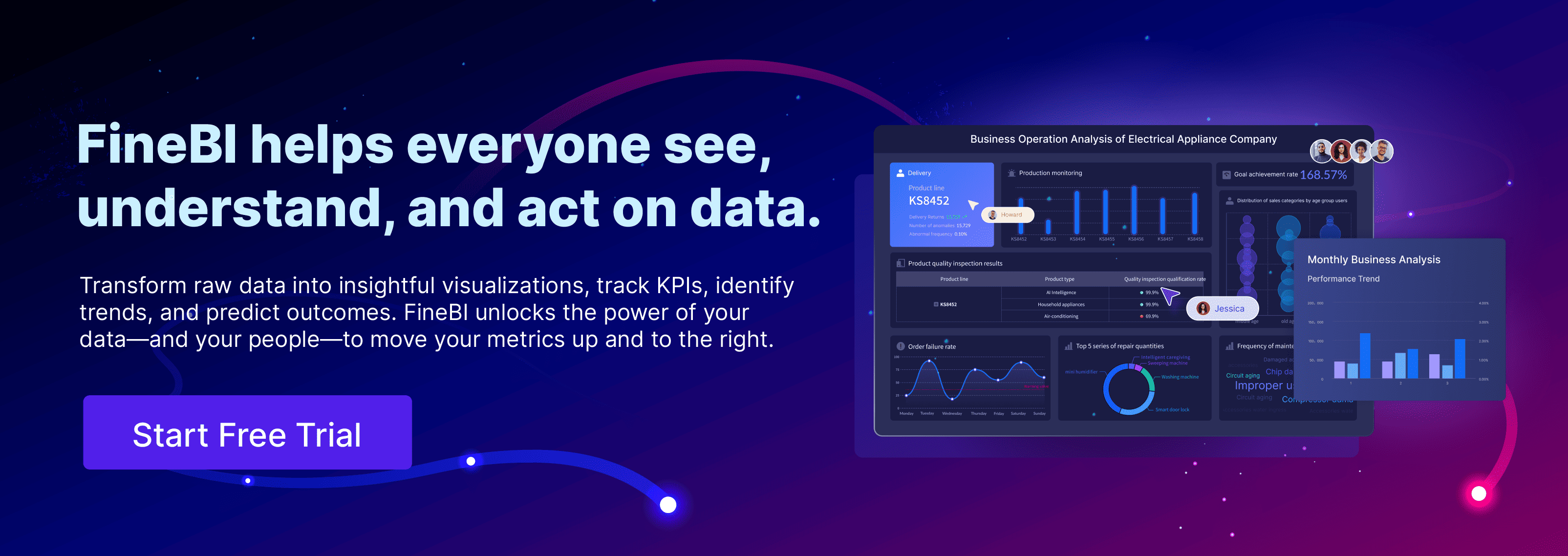Organizations face rapid change as emerging business intelligence trends redefine how they compete in 2025. Key areas include self-service analytics, cloud-based solutions, predictive analytics, AI integration, and advanced visualization techniques. These trends empower users to generate actionable insights quickly, automate analysis, and drive real-time decisions. Recent studies confirm that adopting new business intelligence technologies boosts process efficiency and firm performance. FanRuan’s FineBI and FineChatBI help companies seize these opportunities, ensuring they stay ahead in a competitive market.
Every demo in this article was designed using FineBI. Ready to unlock smarter insights? Click below to start your free FineBI trial and see what’s possible!
Emerging Business Intelligence Trends
Augmented Analytics
Augmented analytics stands at the forefront of emerging business intelligence trends. This approach leverages advanced statistical methods, artificial intelligence, and machine learning to automate data preparation, insight generation, and visualization. Platforms like FineBI simplify complex analytics for business users by providing machine-assisted insights, smart data preparation, and natural language interactions.
Key features of augmented analytics include:
- Forecasting and clustering to uncover hidden patterns in data.
- One-click machine learning in dashboards for outlier detection and cluster analysis.
- Automated data profiling to identify anomalies and improve data quality.
- AI chatbots that enable users to query data and generate actionable insights using natural language.
These capabilities democratize analytics, making it accessible to users across departments. Augmented analytics speeds up analysis, improves accuracy, and enables intuitive engagement with data. FineBI’s self-service modules allow users to perform grouping, calculations, joins, and unions with real-time previews. The platform’s extensive visualization options help users explore relationships and trends, while enterprise-level authorization ensures secure collaboration. By integrating natural language query features, FineBI empowers teams to transition quickly from raw data to actionable insights, supporting faster and more effective decision-making.
Tip: Augmented analytics augments human intelligence, providing personalized, contextual insights and fostering collaboration for better business outcomes.
AI & Machine Learning
Artificial intelligence and machine learning drive innovation in business intelligence. These technologies automate repetitive tasks, enhance predictive analytics, and deliver real-time insights. FineBI integrates AI-driven features that analyze data patterns, predict trends, and support operational efficiency.
| Advancement Area | Description / Function | Business Impact / Benefit |
|---|---|---|
| AI Tools | Manage multi-channel conversations with context | Improve efficiency and ensure consistent customer service |
| Data Management | Centralize and organize customer information | Enable informed decisions and provide a unified customer view |
| Personalization | Tailor interactions using customer data | Boost customer satisfaction and strengthen loyalty |
| Explainable AI (XAI) | Make AI systems transparent and trustworthy | Build trust, meet regulations, detect biases |
| Deep Learning Advances | Use CNNs, RNNs, transfer learning for data analysis | Improve predictive accuracy and operational efficiency |
| Privacy-First ML Methods | Differential privacy, federated learning, encryption | Protect data privacy and comply with regulations |
| AutoML Platforms | Automate ML tasks for non-technical users | Democratize AI use, accelerate deployment and adoption |
| NLP and Computer Vision | Enhance customer service and data analysis | Drive efficiency, improve customer experience |
FineBI’s AI and ML automation in data preparation and predictive modeling improves decision-making accuracy and operational efficiency. Real-time insights help organizations respond quickly to market changes and operational challenges. AI-powered predictive analytics identify trends, forecast risks, and optimize inventory. Integration with reporting tools enhances collaboration and supports a data-driven culture. Automated reporting and anomaly detection save time and allow teams to focus on strategic decisions. Augmented analytics, combining AI, ML, and NLP, empowers citizen data scientists and accelerates decision-making.

Note: Ethical AI adoption, data quality, and strategic implementation remain critical for maximizing the benefits of artificial intelligence and machine learning in business intelligence.
Data Mesh & Federated Architecture
Data mesh and federated architecture represent a significant shift in business intelligence trends. These emerging trends decentralize data ownership, aligning it with business domains and enabling domain teams to manage their own data products. This approach improves scalability, data integration, and usability for analytics and advanced analytics.
Key principles of data mesh and federated architecture include:
- Domain ownership: Domain teams take responsibility for their data, improving quality and relevance.
- Data as a product: Data is treated as a product with consumers beyond the domain, requiring high quality and usability.
- Self-serve data platforms: Domain teams build and manage data products autonomously, reducing dependency on central teams.
- Federated governance: Ensures interoperability, standardization, and compliance across decentralized data products.
FineDataLink supports these principles by providing a modern data integration platform. It enables organizations to synchronize data across multiple sources in real-time, perform advanced ETL operations, and develop APIs for seamless data sharing. FineBI leverages FineDataLink to streamline data pipelines, ensuring consistent, high-quality data delivery for analytics. This distributed, product-oriented ecosystem accelerates data-driven decision-making and supports scalable, domain-aligned business intelligence systems.
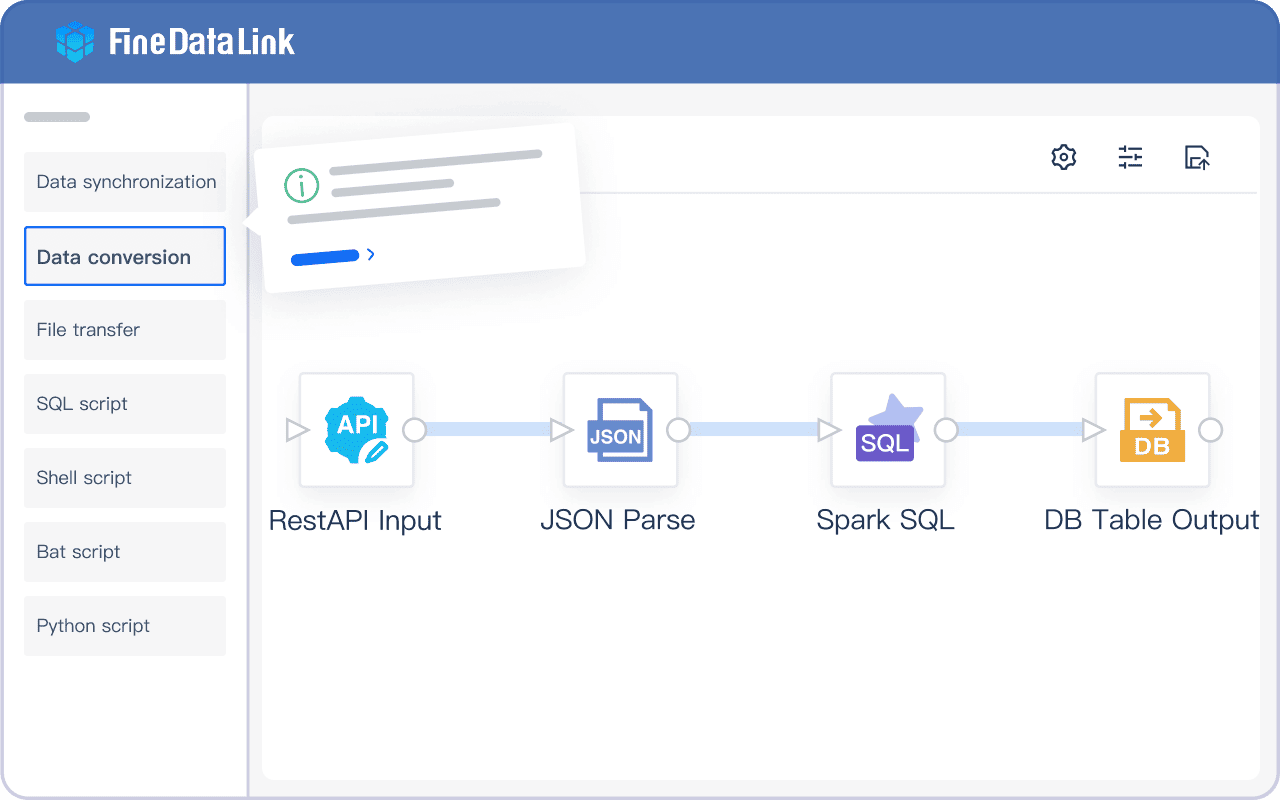
Callout: Data mesh and federated architecture reduce bottlenecks, foster agility, and empower domain teams to deliver actionable insights faster.
Self-Service Emerging Business Intelligence
Empowering Users
Self-service BI transforms how organizations approach analytics by putting the power of data directly into the hands of business users. Employees no longer need to rely on IT teams for every report or dashboard. Instead, they can independently access, analyze, and visualize data from multiple sources. This shift accelerates the speed to insights and enables faster, smarter decision-making.
Key benefits of self-service BI include:
- Empowers non-technical users to generate insights without coding.
- Enables ad hoc queries, dashboard creation, and report generation.
- Connects seamlessly to databases, CRM, ERP, and marketing tools.
- Reduces costs by minimizing IT involvement and infrastructure needs.
- Facilitates collaboration and data sharing across teams.
- Enhances flexibility and agility to respond to market changes.
- Fosters a data-driven culture by removing technical barriers.
FineBI exemplifies these advantages with its intuitive drag-and-drop interface and step-by-step data preparation. Users can perform grouping, calculations, joins, and unions with real-time previews. The platform supports a wide range of data visualizations, making it easy to explore relationships and trends. Enterprise-level authorization ensures secure collaboration between business and IT, while real-time analytics keep everyone aligned with the latest information.

Self-service BI not only improves productivity but also creates a single version of the truth, enabling organizations to act on reliable, up-to-date data.
Low-Code/No-Code Platforms
Low-code and no-code platforms have revolutionized self-service BI adoption. These tools allow users to build dashboards, reports, and analytics applications without writing code. By 2025, the no-code market is expected to reach $48.1 billion, reflecting rapid growth and widespread acceptance.
Key impacts of low-code/no-code platforms:
- Accelerate BI app development, reducing time from months to minutes.
- Democratize data access, enabling non-technical users to generate insights.
- Lower costs by reducing the need for large developer teams.
- Promote operational agility and faster responses to business needs.
- Support integration with multiple data sources for unified analytics.
FineBI and FineChatBI leverage these trends by offering user-friendly interfaces and natural language processing. Business users can query data, generate reports, and visualize results through conversational commands. This approach eliminates bottlenecks, reduces reliance on technical teams, and empowers employees to drive data-driven decisions across the organization.
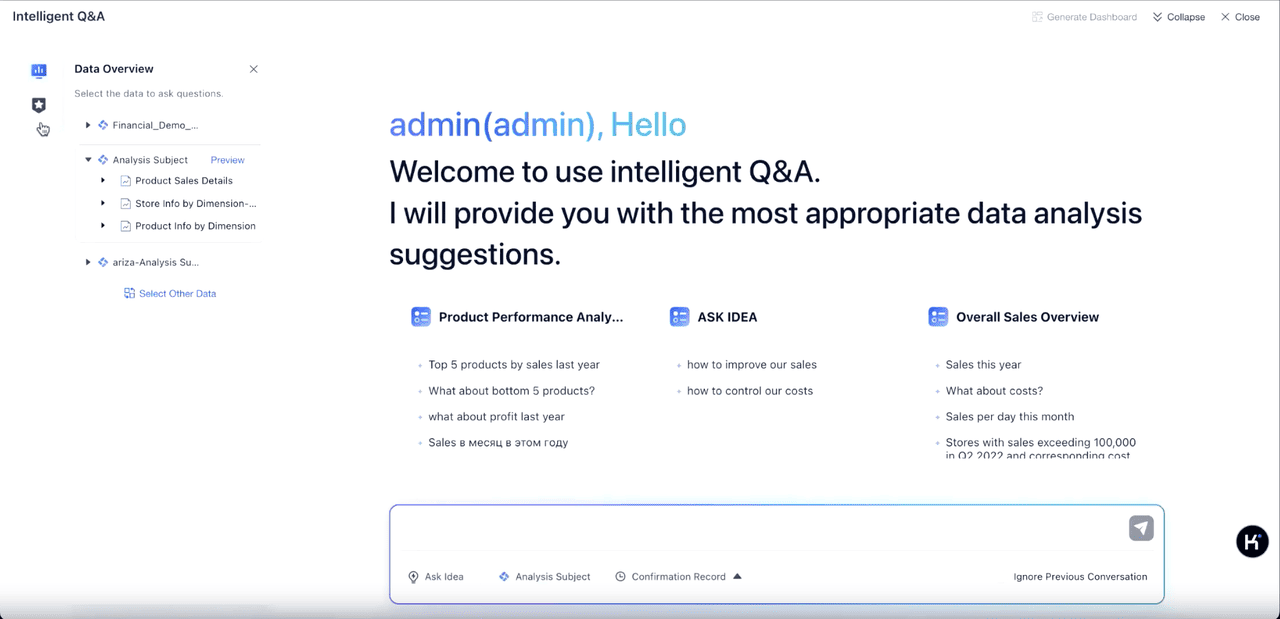
Conversational Analytics & Natural Language BI

FineChatBI Capabilities
FineChatBI introduces a new era of conversational analytics for business intelligence. The platform uses Text2DSL technology to convert natural language queries into structured data queries. This process allows users to ask questions in everyday language and receive accurate, actionable insights. FineChatBI combines rule-based models for simple queries and large language models for complex requests. This hybrid approach ensures precision and speed. Users can engage in multi-round dialogues, maintaining context for follow-up questions. The system supports input association and fuzzy matching, guiding users to formulate effective questions. Chart generation rules and flexible chart switching help users visualize data instantly. Most queries respond within seconds, improving user engagement and decision-making speed.
FineChatBI lowers barriers to analytics by making data interaction intuitive and accessible for everyone in the organization.
Key features of conversational analytics in modern BI platforms include:
- Query understanding that translates natural language into structured database queries.
- Context recognition for idioms, synonyms, and business jargon.
- Sentiment analysis to measure tone in qualitative data.
- Natural language generation for summaries and recommendations.
- Ease of use for non-technical users, democratizing data access.
- Immediate insights that accelerate decision-making.
- AI agents that retrieve, plan, synthesize, and act on data requests.
These capabilities foster a data-literate culture and make analytics available to a wider audience.
NLP in BI Tools
Natural language processing (NLP) transforms how users interact with business intelligence tools. NLP enables conversational queries, allowing users to explore analytics using everyday language. This approach automates report generation and delivers real-time, context-rich insights. NLP can analyze unstructured data, such as customer feedback or social media posts, revealing hidden trends. BI tools powered by NLP understand follow-up questions, maintaining conversation history for seamless interaction. Voice-activated systems and chatbots make data access possible on mobile devices, increasing flexibility.
NLP bridges the gap between complex data structures and human understanding, making analytics more user-friendly and efficient.
- Democratizes data access by removing technical barriers.
- Automates analytics workflows, saving time and ensuring consistency.
- Supports self-service analytics, empowering non-technical users.
- Enhances decision-making by compressing traditional BI workflows from days to minutes.
- Ensures robust security and governance for appropriate data access.
NLP continues to evolve, shifting from simple query translation to true understanding and delivery of actionable answers. This transformation increases user engagement and broadens analytics adoption across organizations.
Real-Time & Cloud Business Intelligence
Real-Time Data Integration
Organizations today demand immediate access to accurate data. Real-time data integration has become essential for business intelligence. FineDataLink enables companies to synchronize data across multiple sources in real-time, ensuring that every decision is based on the latest information. The platform supports non-intrusive real-time synchronization using methods like timestamp, trigger, and log parsing. This approach keeps business data updated and ready for analysis.
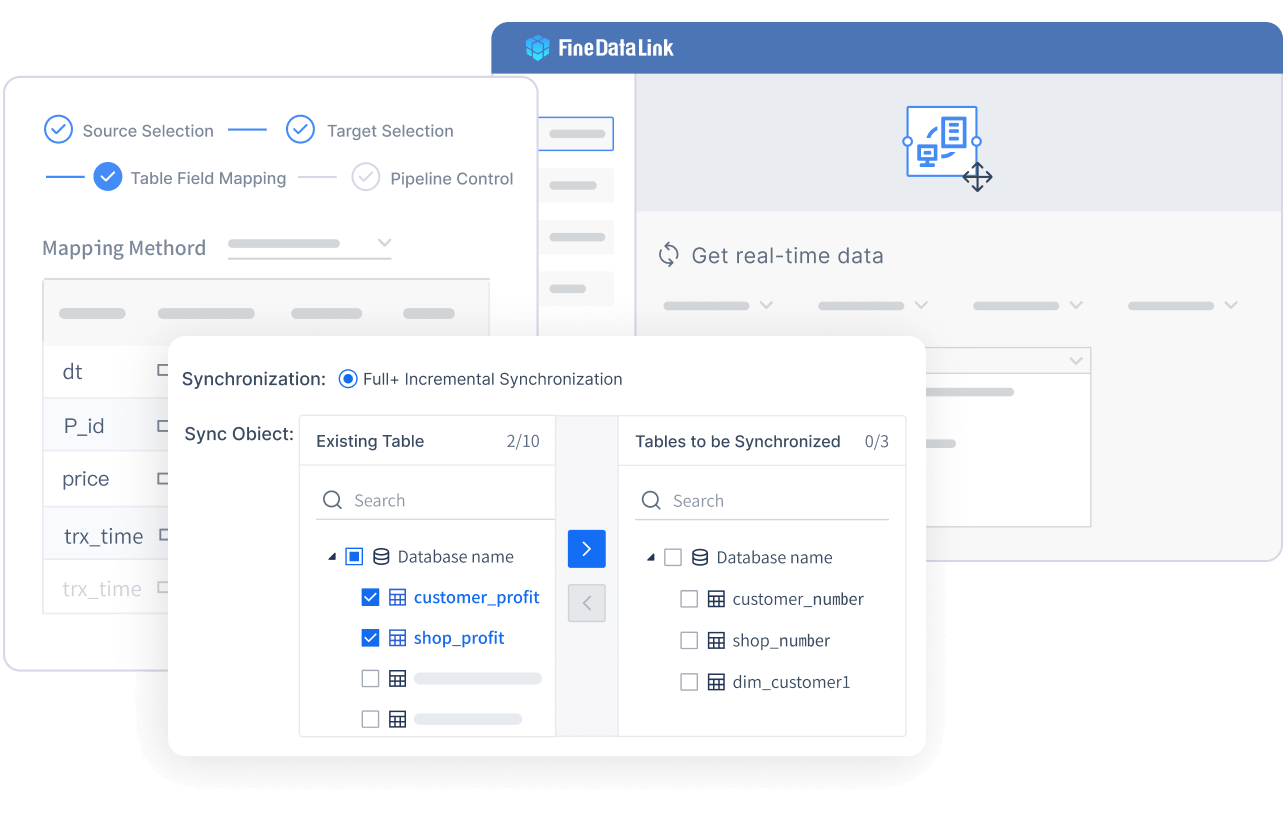
Real-time data integration offers several advantages:
- Teams can monitor key metrics as they happen, improving agility and enabling immediate responses.
- Companies can adjust pricing and promotions instantly, maximizing revenue and market share.
- Real-time analytics shift decision-making from reactive to proactive, increasing agility and minimizing risks.
- Unified data from different sources provides a single, real-time view for stakeholders.
- Real-time insights reduce time-to-action by removing manual data aggregation.
- Personalized, timely customer interactions improve satisfaction and loyalty.
- Real-time analytics support faster experimentation and innovation through rapid feedback loops.
- Integrated data across touchpoints creates a seamless customer experience.
- Organizations gain a competitive advantage by identifying trends early and optimizing operations.
- Real-time analytics enable faster and more accurate decision-making, supporting sustainable growth.
FineDataLink’s high-performance real-time synchronization engine automates cross-domain data updates, reduces latency, and ensures data consistency. The platform’s cluster deployment supports high availability, disaster recovery, and scalability, making it ideal for enterprises with complex data needs.
Cloud BI Solutions
Cloud bi solutions have transformed how enterprises manage and analyze data. FanRuan’s products, including FineBI and FineDataLink, support scalable, cloud-based BI infrastructure. These solutions allow organizations to access real-time analytics from anywhere, supporting remote teams and multi-location operations.
Key benefits of cloud bi solutions include:
- Scalability: Cloud-native platforms adjust resources dynamically to handle increases in data volume.
- Flexibility: Users can access analytics tools from any location with internet connectivity.
- Integration: Seamless connection with other cloud-based applications creates unified environments.
- Cost Efficiency: Pay-as-you-go pricing reduces upfront investments and IT overhead.
- Enhanced Collaboration: Real-time multi-user access and shared dashboards accelerate decision-making.
- Security and Compliance: Advanced features protect business data and ensure regulatory compliance.
FineDataLink integrates data from relational databases, APIs, and cloud storage, maintaining consistency and reliability. Automated real-time data synchronization keeps analytics up-to-date, while seamless data transformation ensures information is ready for analysis. The platform’s strong horizontal scalability and cluster management simplify deployment and maintenance, supporting high concurrent access and traffic fluctuations.
FanRuan’s cloud bi solutions empower organizations to harness real-time analytics, unify fragmented data, and drive informed decisions at scale.
Data Governance & Security
AI-Driven Governance
Modern business intelligence platforms rely on robust data governance to ensure security, compliance, and trust. FineBI addresses these needs with enterprise-level data permission control. Administrators can assign access based on department, role, or responsibility. Sensitive information remains protected through data masking and granular permissions. This approach supports organizations as they adopt new data management trends.
AI-driven governance has transformed how companies manage data security and compliance. Automated systems monitor data usage and enforce policies such as GDPR and HIPAA. AI continuously cleans, tags, and standardizes data, reducing manual intervention. Adaptive access controls adjust permissions in real time, preventing unauthorized access. The table below summarizes key aspects of AI-driven governance:
| Aspect | Description |
|---|---|
| Automated Compliance Enforcement | AI monitors data usage and enforces privacy policies in real time. |
| Data Quality Improvement | AI cleans and standardizes data for trustworthy insights. |
| Adaptive Access Controls | AI adjusts permissions based on sensitivity and usage patterns. |
| Continuous Monitoring | AI adapts governance rules as business and regulatory needs evolve. |
AI-driven governance supports data-driven decision making by ensuring only high-quality, compliant data enters analytics workflows. This foundation enables predictive analytics and supports the latest data management trends.
Data Quality Management
High-quality data forms the backbone of effective business intelligence. FineBI integrates advanced data profiling, cleansing, and validation tools. These features help organizations detect and correct errors, remove duplicates, and standardize formats. Automated monitoring and reporting keep data quality high over time.
Key methods for data quality management include:
- Data profiling to analyze structure, types, and patterns.
- Cleansing to merge duplicates and correct inconsistencies.
- Standardization to apply consistent formats and labels.
- Validation against business and compliance rules.
- Continuous monitoring with automated alerts for quality issues.
Organizations assign clear roles such as data stewards and owners to maintain quality throughout the data lifecycle. Automation reduces manual effort and ensures that data entering BI workflows meets strict standards. High-quality data supports predictive analytics and enables organizations to stay ahead of evolving data management trends. Reliable data empowers teams to make data-driven decisions with confidence.
Tip: Investing in data governance and quality management not only protects sensitive information but also drives innovation and operational efficiency.
Advanced Visualization & Data Storytelling
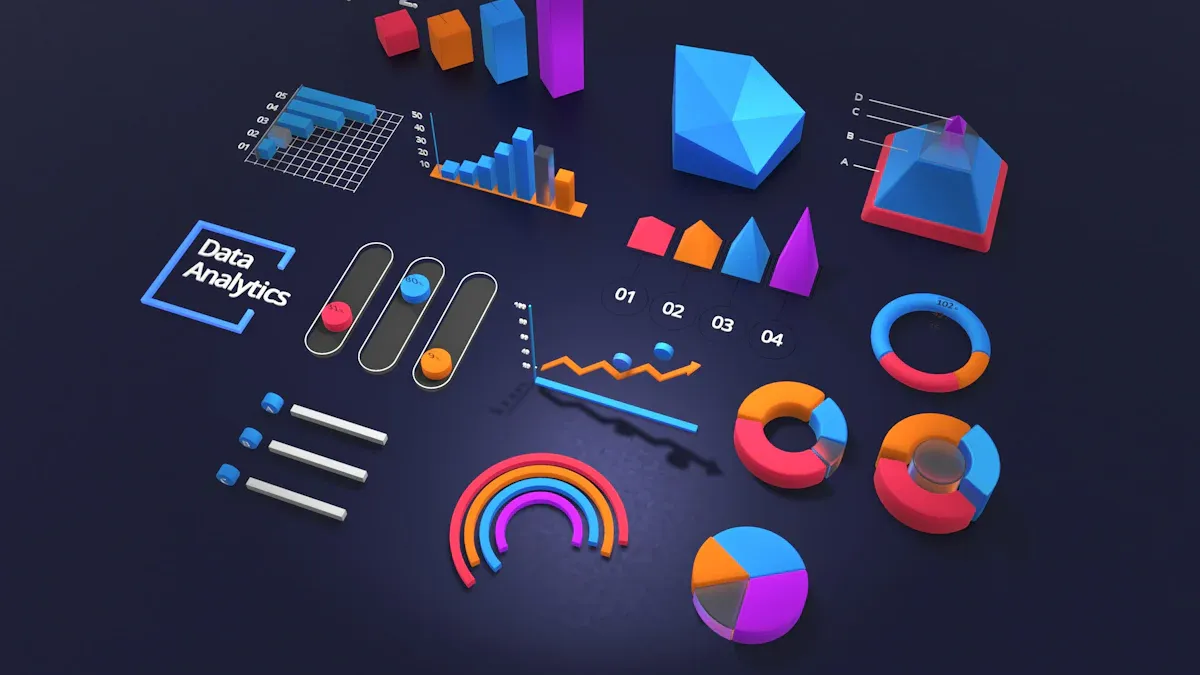
Interactive Dashboards
Advanced visualization techniques have transformed business intelligence by making complex data accessible and actionable. FineBI offers a rich suite of visualization components, including over 60 chart types and advanced options like geospatial mapping and animated visualizations. These tools allow users to build interactive dashboards that present real-time data from multiple sources in a single, unified view.
Interactive dashboards provide several benefits for business decision-makers:
- Real-time updates deliver immediate insight into critical metrics.
- Customizable layouts highlight the most relevant data for each user or department.
- Integration of multiple data sources eliminates silos and ensures a single version of the truth.
- User-friendly design makes data accessible to all employees, not just analysts.
- Faster, more accurate decision-making gives organizations a competitive edge.
| Company | Visualization Technique Used | Impact on Business Intelligence and Data Storytelling |
|---|---|---|
| Lenovo | Interactive dashboards (Tableau) | Improved efficiency by 95%, enabled flexible ad-hoc analyses, enhanced decision-making across 28 countries. |
| Centralized data with interactive dashboards | Empowered 90% of sales force with real-time data access, reduced analyst burden, enabled faster data-driven decisions. | |
| Starbucks | BI integration with loyalty program | Boosted customer engagement, personalized marketing, optimized customer experience, increased sales and retention. |
FineBI’s interactive dashboards empower users to explore data dynamically, filter results, and drill down into details. This hands-on approach encourages a data-driven culture and supports rapid, informed decision-making.
Data Interpretation
Data interpretation features in FineBI help users move beyond simple visualization to uncover actionable insights. The platform’s DEF function enables highly customizable analysis and report creation, addressing real-world data challenges with detailed calculations. Users can filter, slice, sort, and aggregate data without coding, making deep exploration accessible to everyone.
FineBI supports classic analysis models such as pyramid, KANO, and RFM, which help businesses extract valuable insights from their data. Intelligent visualization options highlight key findings and trends, making it easier for decision-makers to understand and act on information. By structuring visualizations logically and adding annotations, FineBI enhances data storytelling and improves retention.
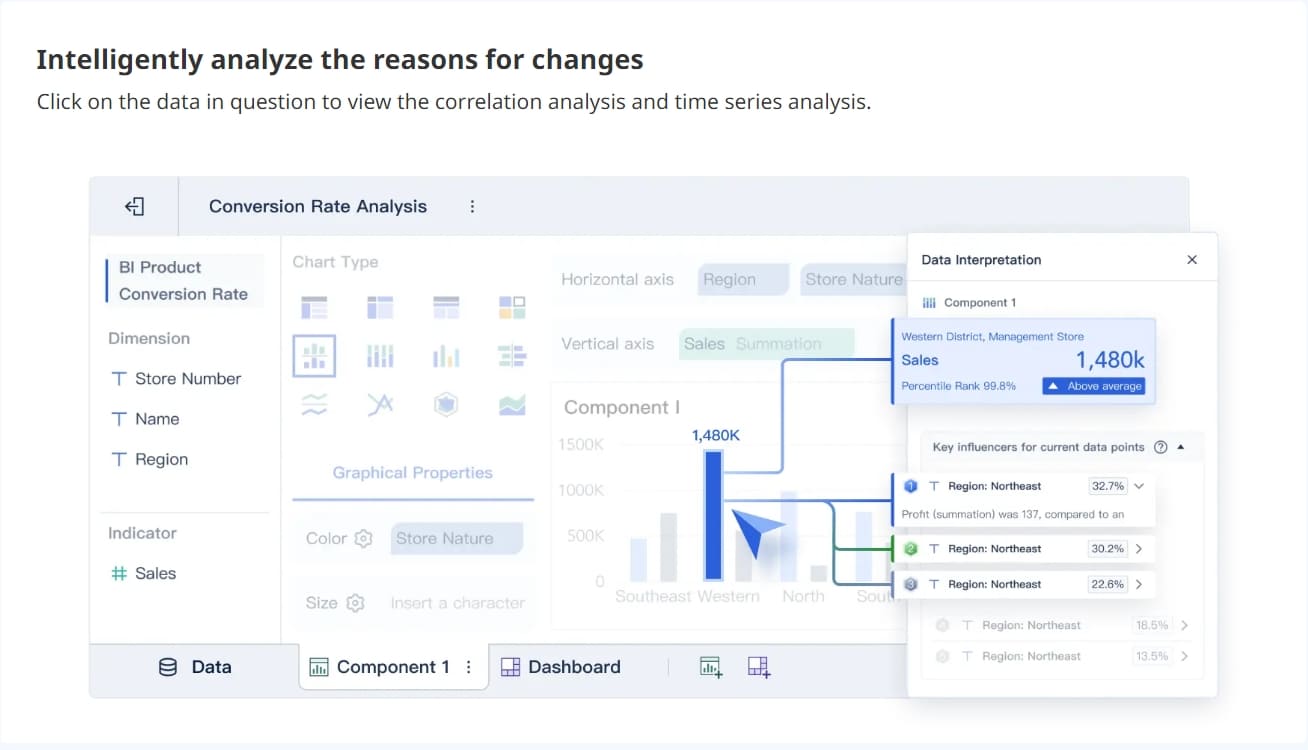
Tip: Advanced visualization and data interpretation transform raw data into compelling stories that drive better decision-making and inspire action.
These capabilities ensure that organizations can leverage data for strategic advantage, enabling teams to respond quickly to opportunities and challenges.
Embedded & Composable Business Intelligence
Embedded Analytics
Embedded analytics has become a key trend in business intelligence. Companies now integrate real-time insights directly into business applications. This approach removes the need to switch between separate analytics tools. Users see relevant data within their workflow, which speeds up decision-making and improves efficiency.
- Embedded analytics delivers contextual insights at the moment of need.
- It streamlines operations by reducing time spent gathering information.
- Users interact with familiar interfaces, which increases adoption and makes analytics accessible to everyone.
- Companies improve customer experience by offering self-service data insights in customer-facing apps.
- Advanced analytics features, such as machine learning and natural language processing, provide a competitive edge.
- Embedded analytics supports scalability and security, helping organizations grow and protect data.
- Software providers can create new revenue streams by upselling analytics features.
FanRuan’s FineBI and FineChatBI integrate seamlessly into enterprise workflows. Teams access interactive dashboards and automated insights within their daily applications. This integration fosters a data-driven culture and enhances productivity across departments.
Embedded analytics transforms business processes by making data a natural part of everyday work.
Composable BI Solutions
Composable business intelligence solutions offer flexibility and adaptability. These platforms separate data ingestion, transformation, modeling, visualization, and output into modular components. Teams select and update the best tools for each function, avoiding rigid systems.
Composable BI fits into evolving workflows. Organizations automate tasks, reduce manual work, and customize processes without disrupting the entire system. Modular architecture allows independent development and quick updates. Companies respond faster to changing business needs and onboard new partners efficiently.
FanRuan’s solutions support composable BI through integration with legacy systems and cloud platforms. FineBI and FineDataLink provide building blocks for data management, analytics, and visualization. Enterprises tailor workflows to fit their unique requirements, improving operational efficiency and supporting growth.
Composable BI empowers organizations to adapt quickly, reduce technical debt, and build flexible systems that scale with business demands.
Trends for Emerging Business Intelligence
Synthetic Data & Edge Computing
Synthetic data and edge computing represent two of the most important emerging trends in business intelligence. Synthetic data protects sensitive information while enabling analytics, helping organizations overcome data limitations and balance imbalanced datasets. This approach improves analytics accuracy and allows teams to simulate scenarios, test feasibility, and assess risks. Synthetic data also supports privacy and compliance, making it valuable in regulated industries.
Edge computing processes data close to its source, reducing costs and speeding up analytics. This method enables real-time data processing, which is essential for IoT applications and predictive maintenance. Edge nodes filter data before transmission, lowering network load and storage costs. Some edge components operate offline, ensuring continuity even in unstable networks. Edge computing also enhances security by processing sensitive data locally and minimizing exposure. As the edge computing market grows rapidly, organizations gain faster decision-making and improved data security.
BI as a Service (BIaaS)
BI as a Service (BIaaS) transforms how organizations access and scale business intelligence. BIaaS consolidates data from multiple sources, providing enriched and accurate insights. Automated data transformation and modeling align information with business needs, supporting high-quality reporting and predictive analysis. The platform offers real-time collaboration on interactive dashboards, enhancing team decision-making.
BIaaS leverages cloud computing to reduce upfront costs and enable rapid deployment. Teams can access analytics tools from anywhere, supporting a flexible and agile data-driven landscape. Self-service capabilities empower non-technical users to generate reports independently, accelerating data-driven decision making. Integration with AI enables advanced analytics, while robust governance ensures data quality and compliance.
Data-Driven Culture & Collaboration
A strong data-driven culture is essential for success in the modern business intelligence environment. Leadership must champion data-driven decision making and provide employees with relevant, accurate data. Organizations invest in modern BI platforms like FineBI to facilitate analysis and visualization. Training programs build data literacy, helping employees interpret and act on insights.
Collaboration thrives when teams share data and insights across departments. FineBI’s team features support cross-functional projects, enabling users to work together on dashboards and reports. Clear goals, regular communication, and recognition of data-driven achievements reinforce a culture of experimentation and continuous improvement. By embedding data into daily workflows, organizations ensure that data-driven practices become second nature, driving innovation and sustained growth.
Emerging business intelligence trends continue to redefine how organizations approach decision-making. Companies that proactively adopt advanced analytics, real-time integration, and AI-driven tools gain a measurable edge. By focusing on robust data governance, scalable architecture, and user-friendly dashboards, teams can accelerate decision-making and foster a culture of collaboration. Leveraging solutions like FineBI and FineChatBI, organizations address evolving business needs and ensure their business intelligence strategies remain agile. Regularly measuring ROI, investing in training, and prioritizing seamless data integration help sustain long-term success.
Continue Reading About Emerging Business Intelligence
What Does a Business Intelligence Developer Do in 2025
Top Business Intelligence Services Providers to Watch in 2025
What Does a Business Intelligence Engineer Do in 2025
Top Business Intelligence Tools to Explore in 2025
FAQ
What is the main advantage of using FineBI for business intelligence?
FineBI empowers users to analyze data independently. The platform offers a drag-and-drop interface, real-time dashboards, and secure data sharing. Teams gain faster insights and make better decisions without relying on IT specialists.
How does FineChatBI improve data accessibility for non-technical users?
FineChatBI uses natural language processing. Users ask questions in plain language and receive instant answers. The system translates queries into structured data searches, making analytics easy for everyone.
Is data security a priority in FanRuan’s BI solutions?
Data security remains a top priority. FineBI provides role-based access control, data masking, and audit trails. Administrators manage permissions to protect sensitive information and ensure compliance with industry standards.

The Author
Lewis
Senior Data Analyst at FanRuan
Related Articles

Reviews of Data Intelligence Companies Leading the Industry
Compare top data intelligence companies and platforms, highlighting key features, integration, and business impact for informed decision-making.
Lewis
Nov 11, 2025

What Is Enterprise BI and Why Should You Care
Enterprise BI empowers organizations with real-time insights, scalable analytics, and unified data, driving smarter decisions and a competitive edge.
Lewis
Nov 09, 2025

Business Intelligence Engineer Amazon Salary Revealed
The average business intelligence engineer amazon salary in 2025 is $101,752, with total compensation reaching up to $224,000 based on level.
Lewis
Sep 09, 2025
